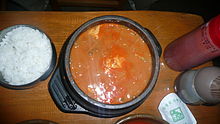- Cheonggukjang
-
Cheonggukjang 
Korean name Hangul 청국장 Hanja 淸麴醬 Revised Romanization cheonggukjang McCune–Reischauer ch'ŏnggukchang Cheonggukjang (Korean pronunciation: [tɕʰʌŋɡuk̚tɕ͈aŋ]) is a fermented soybean paste used in Korean cuisine. It contains whole as well as ground soybeans.
Contents
Production
It can be made in 2 to 3 days through fermentation of boiled soybeans, adding Bacillus subtilis, which is usually contained in the air or in the jip, dried rice plants, at 40 °C without adding salt, compared with the much longer fermentation period required for doenjang, another, less pungent variety of Korean soybean paste. Like many forms of doenjang, cheonggukjang is paste-like in texture, but also includes some whole, uncrushed soybeans.
Cheonggukjang may also be made by fermenting boiled soybeans in a warm place, pounding a portion of them, and adding salt and red chili powder.
History
Cheonggukjang is most often used to prepare a stew, which is also simply called cheonggukjang, but may be called cheonggukjang jjigae to avoid confusion.photo Cheonggukjang jjigae often includes additional ingredients, such as potatoes, onions, and tofu.
Nutrition and health
Cheonggukjang is generally considered to be a healthy food (particularly in the winter), as it is rich in vitamins and other nutrients, though its very strong odor is not universally enjoyed. Some people have commented that this soup gives off the aroma of wet socks. Doenjang may be used to replace it by people who dislike its smell.
In 1993, odorless cheonggukjang was invented by Dr. Hyun Kyu JOO, a former professor of KunKook Univ. and obtained a patent in 1998 on a method for removing this food's characteristic smell.
Cheonggukjang is also believed to aid in digestion. For this purpose, cheonggukjang pills are produced in South Korea.
See also
- Korean cuisine
- Jjigae
- Yellow soybean paste
- Fermented bean paste
- Doenjang
- Natto
- Miso
- dòuchǐ
- Stinky tofu
- Tempeh
References
External links
- Cheonggukjang recipe
- Cheonggukjang jjigae recipe
- Cheonggukjang site (Korean)
- Cheonggukjang recipe with pictures
Soy General Soy allergy · Soy candle · Soy ink · Soy molasses · Soy paint · Soy protein · Soybean · Soybean diseases · Soybean meal · Soybean oil

Soy based dishes Aburaage · Agedashi tofu · Bai ye · Douhua · Dubu kimchi · Edamame · Hiyayakko · Kongguksu · Kongnamul · Mapo doufu · Miso soup · Sundubu jjigae · Tahu goreng · Tofu skin roll · Yong Tau Foo
Milk substitute Meat analogues Sauces and condiments Dajiang · Doenjang · Doubanjiang · Douchi · Kinema · Miso · Nattō · Soy sauce · Teriyaki · Tauco · Tian mian jiang · Tương · Yellow soybean paste
Various other foods Companies 8th Continent · Alpro · Boca Burger · Gardenburger · Morningstar Farms · Silk · So Good · Tofutti · Turtle Mountain · Vitasoy · Yeo Hiap Seng
Categories:- Korean condiments
- Soy products
- Fermented foods
Wikimedia Foundation. 2010.
